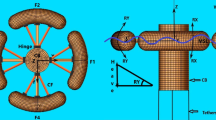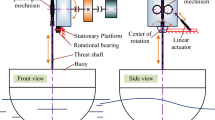Abstract
Wave energy is an important type of marine renewable energy. A wave energy converter (WEC) moored with two floating bodies was developed in the present study. To analyze the dynamic performance of the WEC, an experimental device was designed and tested in a tank. The experiment focused on the factors which impact the motion and energy conversion performance of the WEC. Dynamic performance was evaluated by the relative displacements and velocities of the oscillator and carrier which served as the floating bodies of WEC. Four factors were tested, i.e. wave height, wave period, power take-off (PTO) damping, and mass ratio (R M) of the oscillator and carrier. Experimental results show that these factors greatly affect the energy conversion performance, especially when the wave period matches R M and PTO damping. According to the results, we conclude that: (a) the maximization of the relative displacements and velocities leads to the maximization of the energy conversion efficiency; (b) the larger the wave height, the higher the energy conversion efficiency will be; (c) the relationships of energy conversion efficiency with wave period, PTO damping, and R M are nonlinear, but the maximum efficiency is obtained when these three factors are optimally matched. Experimental results demonstrated that the energy conversion efficiency reached the peak at 28.62% when the wave height was 120 mm, wave period was 1.0 s, R M was 0.21, and the PTO damping was corresponding to the resistance of 100 Ω.
Similar content being viewed by others
References
Abraham, E. and Kerrigan, E.C., 2012. Optimal active control of a wave energy converter, Proceedings of 51st Annual Conference on Decision and Control, IEEE, Maui, HI,USA, 2415–2420.
de Backer, G., 2009. Hydrodynamic Design Optimization of Wave Energy Converters Consisting of Heaving Point Absorbers, Ph.D. Thesis, Department of Civil Engineering, Ghent University.
Bachynski, E.E., Young, Y.L. and Yeung, R.W., 2012. Analysis and optimization of a tethered wave energy converter in irregular waves, Renewable Energy, 48, 133–145.
Cochet, C. and Yeung, R.W., 2012. Dynamic analysis and configuration design of a two-component wave-energy absorber, Proceedings of the 31st International Conference on Ocean, Offshore, and Arctic Engineering, ASME, Rio de Janeiro, Brazil, Paper No. OMAE2012-83613, pp. 631–640.
Count, B.M. and Evans, D.V., 1984. The influence of projecting sidewalls on the hydrodynamic performance of wave-energy devices, Journal of Fluid Mechanics, 145, 361–376.
Cruz, J., 2008. Ocean Wave Energy: Current Status and Future Perspectives, Springer, Berlin Heidelberg.
Evans, D.V., 1976. Theory for wave power absorption by oscillating bodies, Journal of Fluid Mechanics, 77, 1–25.
Eriksson, M., Isberg, J. and Leijon, M., 2005. Hydrodynamic modelling of a direct drive wave energy converter, International Journal of Engineering Science, 43(17–18), 1377–1387.
Falcão, A.F.D.O., 2007. Modelling and control of oscillating-body wave energy converters with hydraulic power take-off and gas accumulator, Ocean Engineering, 34(14–15), 2021–2032.
Falnes, J. and Løvseth, J., 1991. Ocean wave energy, Energy Policy, 19(8), 768–775.
Falnes, J., 2002a. Optimum control of oscillation of wave-energy converters, International Journal of Offshore and Polar Engineering, 12(2), 567–574.
Falnes, J., 2002b. Ocean Waves and Oscillating Systems: Linear Interactions Including Wave-Energy Extraction, Cambridge University Press, Cambridge.
Guo, W., Zhang, L., Zheng, X.B. and Wang, S.Q., 2014. Analysis of hydrodynamic performance of wave energy converter based on CFD, Journal of Huazhong University of Science and Technology, 42(7), 22–26. (in Chinese)
Ivanova, I., Ågren, O., Bernhoff, H. and Leijon, M., 2004. Simulation of a l00 kW permanent magnet octagonal linear generator for ocean wave conversion, Proceedings of the 2004 International Symposium on Underwater Technology (IEEE Cat. No.04EX869), pp. 345–348.
Li, Y. and Yu, Y.H., 2012. A synthesis of numerical method for modeling wave energy converter-point absorbers, Renewable and Sustainable Energy Reviews, 16(6), 4352–4364.
Mueller, M.A., 2002. Electrical generators for direct drive wave energy converters, IEE Proceedings-Generation, Transmission and Distribution, 149(4), 446–456.
Madhi, F., 2012. Design, Fabrication, and Testing of A Horizontal Cylindrical Wave-Energy Device of High Performance, Master’s Thesis, University of California at Berkeley, Berkeley, CA.
Madhi, F., Sinclair, M.E. and Yeung, R.W., 2014. The “Berkeley Wedge”: An asymmetrical energy-capturing floating breakwater of high performance, Marine System & Ocean Technology, 9(1), 5–16.
Price, A.A.E., Dent, C.J. and Wallace, A.R., 2009. On the capture width of wave energy converters, Applied Ocean Research, 31(4), 251–259.
Rhinefrank, K., Agamloh, E.B., von Jouanne, A. Wallace, A.K., Prudell, J., Kimble, K., Aills, J., Schmidt E., Chan, P., Sweeny, B. and Schacher, A., 2006. Novel ocean energy permanent magnet linear generator buoy, Renewable Energy, 31(9), 1279–1298.
Tom, N. and Yeung, R.W., 2013. Performance enhancements and validations of a generic ocean-wave energy extractor, Journal of Offshore Mechanic and Arctic Engineering, 135(4), 041101.
Yeung, R.W., Peiffer, A., Tom, N. and Matlak, T., 2012. Design. analysis, and evaluation of the UC-Berkeley wave-energy extractor, Journal of Offshore Mechanics and Arctic Engineering, 134(2), 021902–1–8.
Zhang, L., Li, X.Z., Geng, J. and Zhang, X.W., 2013. Tidal current energy update 2013, Advances in New and Renewable Energy, 1(1), 53–68. (in Chinese)
Zheng, X.B., Zhang, L. and Ma, Y., 2014. Hydrodynamic calculation and energy conversion performance analysis of double floater wave energy converter, Science and Technology Review, 32(19), 26–30. (in Chinese)
Author information
Authors and Affiliations
Corresponding author
Additional information
Foundation item: The work was financially supported by the Fundamental Research Funds for the Central University (Grant No. HEUCFD1414), the National Ocean Renewable Energy Special Funds (Grant No. TJME2011BL03), the National Natural Science Foundation of China (Grant Nos. 51309068 and 51309069), and the High Technology Ship Scientific Research Project from Ministry of Industry and Information Technology of the People’s Republic of China–Floating Security Platform Project (the second stage).
Rights and permissions
About this article
Cite this article
Zheng, Xb., Ma, Y., Zhang, L. et al. Experimental investigation on the hydrodynamic performance of a wave energy converter. China Ocean Eng 31, 370–377 (2017). https://doi.org/10.1007/s13344-017-0058-6
Received:
Revised:
Accepted:
Published:
Issue Date:
DOI: https://doi.org/10.1007/s13344-017-0058-6




